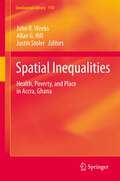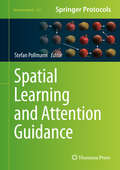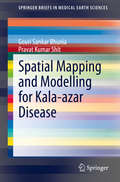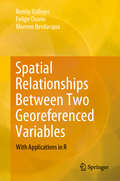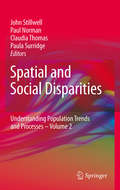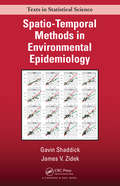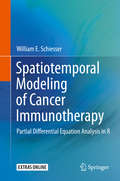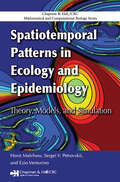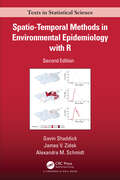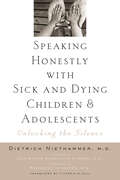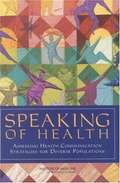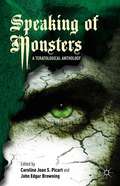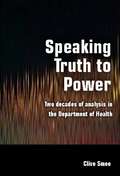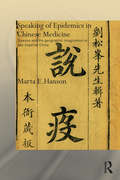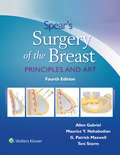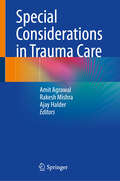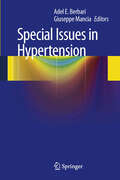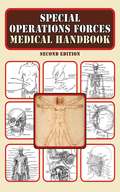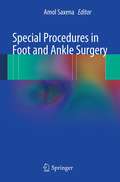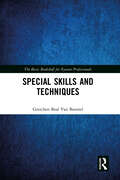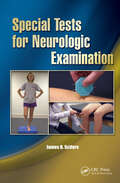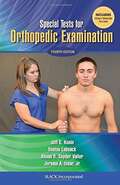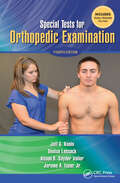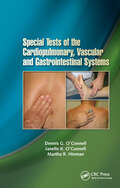- Table View
- List View
Spatial Inequalities
by Allan G. Hill Justin Stoler John R. WeeksThis book provides a fresh analysis of the demography, health and well-being of a major African city. It brings a range of disciplinary approaches to bear on the pressing topics of urban poverty, urban health inequalities and urban growth. The approach is primarily spatial and includes the integration of environmental information from satellites and other geospatial sources with social science and health survey data. The authors Ghanaians and outsiders, have worked to understand the urban dynamics in this burgeoning West African metropolis, with an emphasis on urban disparities in health and living standards. Few cities in the global South have been examined from so many different perspectives. Our analysis employs a wide range of GIScience methods, including analysis of remotely sensed imagery and spatial statistical analysis, applied to a wide range of data, including census, survey and health clinic data, all of which are supplemented by field work, including systematic social observation, focus groups, and key informant interviews. This book aims to explain and highlight the mix of methods, and the important findings that have been emerging from this research, with the goal of providing guidance and inspiration for others doing similar work in cities of other developing nations.
Spatial Learning and Attention Guidance (Neuromethods #151)
by Stefan PollmannThis volume looks at the latest research techniques to study the interaction of visual spatial learning and attention guidance with behavioral, psychophysiological, and imaging methods. Part One (behavioral methods) focuses on different paradigms of visual search like visual foraging and contextual cueing, and also methods like feature distribution analysis and search in virtual reality. Part Two (psychophysiological methods) integrates innovative uses of classical potential changes like the CDA and N2pc, with multivariate analysis methods and multi-method designs. Part Three (functional imaging) covers lesion-behavior mapping, retinotopic and grid cell mapping methods for human fMRI, as well as functional registration by hyperalignment and simultaneous eye-tracking and fMRI. In Neuromethods series style, chapters include the kind of detail and key advice from the specialists needed to get successful results in your laboratory.Cutting-edge and comprehensive, Spatial Learning and Attention Guidance is a valuable resource for all researchers and scientists who are interested in learning more about the relationship between attention and memory.
Spatial Mapping and Modelling for Kala-azar Disease (SpringerBriefs in Medical Earth Sciences)
by Gouri Sankar Bhunia Pravat Kumar ShitThis book addresses the current challenges in controlling Kala-azar disease (Visceral leishmaniasis) in India and other VL-endemic areas, and aims to develop and apply a geo-environmental risk model based on primary and secondary data with the aid of remote sensing and GIS technologies to assess and mitigate Kala-azar transmission. Through case studies carried out in India, the book provides insight into the relationship between geo-environmental variables and encroachments of Kala-azar, and identifies potential pathways for VL introduction to develop mitigation strategies using GIS and remote sensing technologies. The book critically assesses existing VL mitigation measures that do not adequately account for geo-environmental conditions, and analyzes the environmental factors that aid Kala-azar transmission using remote sensing, spatial statistics and data mining techniques. The book will be of interest to epidemiologists, researchers and practitioners using geospatial data practices to study disease transmission and associated monitoring technologies.
Spatial Relationships Between Two Georeferenced Variables: With Applications in R
by Ronny Vallejos Felipe Osorio Moreno BevilacquaThis book offers essential, systematic information on the assessment of the spatial association between two processes from a statistical standpoint. Divided into eight chapters, the book begins with preliminary concepts, mainly concerning spatial statistics. The following seven chapters focus on the methodologies needed to assess the correlation between two or more processes; from theory introduced 35 years ago, to techniques that have only recently been published. Furthermore, each chapter contains a section on R computations to explore how the methodology works with real data. References and a list of exercises are included at the end of each chapter. The assessment of the correlation between two spatial processes has been tackled from several different perspectives in a variety of applications fields. In particular, the problem of testing for the existence of spatial association between two georeferenced variables is relevant for posterior modeling and inference. One evident application in this context is the quantification of the spatial correlation between two images (processes defined on a rectangular grid in a two-dimensional space). From a statistical perspective, this problem can be handled via hypothesis testing, or by using extensions of the correlation coefficient. In an image-processing framework, these extensions can also be used to define similarity indices between images.
Spatial and Social Disparities
by John Stillwell Paul Norman Claudia Thomas Paula SurridgeInequality is one of the major problems of the contemporary world. Significant geographical disparities exist within nations of the developed world, as well as between these countries and those referred to as the 'South' in the Bruntland Report. Issues of equity and deprivation must be addressed in view of sustainable development. However, before policymakers can remove the obstacles to a fairer world, it is essential to understand the nature of inequality, both in terms of its spatial and socio-demographic characteristics. This second volume in the series contains population studies that examine the disparities evident across geographical space in the UK and between different individuals or groups. Topics include demographic and social change, deprivation, happiness, cultural consumption, ethnicity, gender, employment, health, religion, education and social values. These topics and the relationships between them are explored using secondary data from censuses, surveys or administrative records. In volume 1 the findings of research on fertility, living arrangements, care and mobility are examined. Volume 3 will focus on ethnicity and integration.
Spatio-Temporal Methods in Environmental Epidemiology (Chapman & Hall/CRC Texts in Statistical Science)
by Gavin Shaddick James V. ZidekTeaches Students How to Perform Spatio-Temporal Analyses within Epidemiological StudiesSpatio-Temporal Methods in Environmental Epidemiology is the first book of its kind to specifically address the interface between environmental epidemiology and spatio-temporal modeling. In response to the growing need for collaboration between statisticians and
Spatiotemporal Modeling of Cancer Immunotherapy: Partial Differential Equation Analysis in R
by William E. SchiesserThe focus of this book is a detailed discussion of a dual cancer vaccine (CV)-immune checkpoint inhibitor (ICI) mathematical model formulated as a system of partial differential equations (PDEs) defining the spatiotemporal distribution of cells and biochemicals during tumor growth.A computer implementation of the model is discussed in detail for the quantitative evaluation of CV-ICI therapy. The coding (programming) consists of a series of routines in R, a quality, open-source scientific computing system that is readily available from the internet. The routines are based on the method of lines (MOL), a general PDE algorithm that can be executed on modest computers within the basic R system. The reader can download and use the routines to confirm the model solutions reported in the book, then experiment with the model by varying the parameters and modifying/extending the equations, and even studying alternative models with the PDE methodology demonstrated by the CV-ICI model.Spatiotemporal Modeling of Cancer Immunotherapy: Partial Differential Equation Analysis in R facilitates the use of the model, and more generally, computer- based analysis of cancer immunotherapy mathematical models, as a step toward the development and quantitative evaluation of the immunotherapy approach to the treatment of cancer.
Spatiotemporal Patterns in Ecology and Epidemiology: Theory, Models, and Simulation (Chapman & Hall/CRC Mathematical Biology Series)
by Horst Malchow Sergei V. Petrovskii Ezio VenturinoAlthough the spatial dimension of ecosystem dynamics is now widely recognized, the specific mechanisms behind species patterning in space are still poorly understood and the corresponding theoretical framework is underdeveloped. Going beyond the classical Turing scenario of pattern formation, Spatiotemporal Patterns in Ecology and Epidemiology:
Spatio–Temporal Methods in Environmental Epidemiology with R (Chapman & Hall/CRC Texts in Statistical Science)
by Gavin Shaddick James V. Zidek Alexandra M. SchmidtSpatio-Temporal Methods in Environmental Epidemiology with R, like its First Edition, explores the interface between environmental epidemiology and spatio-temporal modeling. It links recent developments in spatio-temporal theory with epidemiological applications. Drawing on real-life problems, it shows how recent advances in methodology can assess the health risks associated with environmental hazards. The book's clear guidelines enable the implementation of the methodology and estimation of risks in practice. New additions to the Second Edition include: a thorough exploration of the underlying concepts behind knowledge discovery through data; a new chapter on extracting information from data using R and the tidyverse; additional material on methods for Bayesian computation, including the use of NIMBLE and Stan; new methods for performing spatio-temporal analysis and an updated chapter containing further topics. Throughout the book there are new examples, and the presentation of R code for examples has been extended. Along with these additions, the book now has a GitHub site (https://spacetime-environ.github.io/stepi2) that contains data, code and further worked examples.Features:• Explores the interface between environmental epidemiology and spatio-temporal modeling• Incorporates examples that show how spatio-temporal methodology can inform societal concerns about the effects of environmental hazards on health• Uses a Bayesian foundation on which to build an integrated approach to spatio-temporal modeling and environmental epidemiology• Discusses data analysis and topics such as data visualization, mapping, wrangling and analysis• Shows how to design networks for monitoring hazardous environmental processes and the ill effects of preferential sampling• Through the listing and application of code, shows the power of R, tidyverse, NIMBLE and Stan and other modern tools in performing complex data analysis and modelingRepresenting a continuing important direction in environmental epidemiology, this book – in full color throughout – underscores the increasing need to consider dependencies in both space and time when modeling epidemiological data. Readers will learn how to identify and model patterns in spatio-temporal data and how to exploit dependencies over space and time to reduce bias and inefficiency when estimating risks to health.
Speaking Honestly with Sick and Dying Children and Adolescents: Unlocking the Silence
by Dietrich NiethammerTalking openly with sick and dying children about their illness is always difficult and often agonizing. It is honesty, however, that these children deserve and need. Dietrich Niethammer, a prominent pediatric oncologist, explains why it is so important to speak frankly and respectfully to young patients about their disease.The question at the heart of this book is how children and adolescents feel and think about death and dying. Dr. Niethammer thoroughly examines the literature on the topic, arguing that children and adolescents not only are capable of discussing their illness but benefit from doing so. Puzzled why it took medical practitioners so long to accept truth-telling in their care of dying children, Niethammer traces the development of this notion from the early twentieth-century work of Sigmund Freud to the discomfort surrounding it still today.Severely sick children and adolescents think about the consequences of their disease, whether adults discuss it with them or not. When adults remain silent, they do a disservice to the children. Dr. Niethammer urges doctors to practice not in silence and denial but in open communication with ill children, giving the children an opportunity to express their fears and anxieties and to cope with their disease on their own terms.Dr. Niethammer's compelling personal experiences combined with the latest research make this a compassionate and invaluable resource for physicians, nurses, social workers, teachers, parents—for all who care for sick and dying children and adolescents.
Speaking Of Health: Assessing Health Communication Strategiesfor Diverse Populations
by Committee on Communication for Behavior Change in the 21st Century: Improving the Health of Diverse PopulationsWe are what we eat. That old expression seems particularly poignant every time we have our blood drawn for a routine physical to check our cholesterol levels. And, it's not just what we eat that affects our health. Whole ranges of behaviors ultimately make a difference in how we feel and how we maintain our health. Lifestyle choices have enormous impact on our health and well being. But, how do we communicate the language of good health so that it is uniformly received-and accepted-by people from different cultures and backgrounds? Take, for example, the case of a 66 year old Latina. She has been told by her doctor that she should have a mammogram. But her sense of fatalism tells her that it is better not to know if anything is wrong. To know that something is wrong will cause her distress and this may well lead to even more health problems. Before she leaves her doctor's office she has decided not to have a mammogram-that is until her doctor points out that having a mammogram is a way to take care of herself so that she can continue to take care of her family. In this way, the decision to have a mammogram feels like a positive step. Public health communicators and health professionals face dilemmas like this every day. Speaking of Health looks at the challenges of delivering important messages to different audiences. Using case studies in the areas of diabetes, mammography, and mass communication campaigns, it examines the ways in which messages must be adapted to the unique informational needs of their audiences if they are to have any real impact. Speaking of Health looks at basic theories of communication and behavior change and focuses on where they apply and where they don't. By suggesting creative strategies and guidelines for speaking to diverse audiences now and in the future, the Institute of Medicine seeks to take health communication into the 21st century. In an age where we are inundated by multiple messages every day, this book will be a critical tool for all who are interested in communicating with diverse communities about health issues.
Speaking Of Monsters
by John Edgar Browning Caroline Joan S. PicartDespite its apparently monolithic definition, 'teratology' (from the Greek word teras, meaning 'monster, ' and the Latin logy, which is derived from the Greek logia, meaning 'a speaking, discourse, treatise, doctrine, theory, science') seems infinitely malleable, flourishing in various rhetorical environments. Teratologies are more than a bestiary: a catalogue of 'freaks' designed to celebrate the 'normal. ' Rather, teratologies illustrate how humor, horror, fantasy and the 'real' cross-fertilize each other, resulting in the possibility of new worlds, ethics, and narratives, emerging. As a general anthology of teratologies, this book simply maps what, in many ways, has already been occurring across several fields, as it tracks the expansion of this term, creating lacunae that form connections across multiple interpretive communities. It is a cross section of how "monster narratives" intersect with "outsider" positions, from different perspectives - such as those of literary critics, film critics, criminologists, law professors, historians, philosophers - and looks into various strategies of destabilizing normative binaries.
Speaking Truth to Power: Two Decades of Analysis in the Department of Health
by Clive SmeeThe Human Rights Act is now in force. Any NHS body that acts in a way that is incompatible with the rights set out in the European Convention on Human Rights may be acting unlawfully. This workbook is a personal perspective based on the authors' experience of health service management and the law. It explains the impact of the Act, raises issues surrounding its implementation, and asks questions about its implications for the future. It has practical exercises to help readers respond to the challenges of the Act, individually or in team sessions. The Human Rights Act and The European Convention on Human Rights are reproduced in full. There is a great deal in the Act that will have subtle implications for how and when health care is provided and for many of the assumptions that are taken for granted.
Speaking for the Dying: Life-and-Death Decisions in Intensive Care (Chicago Series in Law and Society)
by Susan P. ShapiroSeven in ten Americans over the age of age of sixty who require medical decisions in the final days of their life lack the capacity to make them. For many of us, our biggest, life-and-death decisions—literally—will therefore be made by someone else. They will decide whether we live or die; between long life and quality of life; whether we receive heroic interventions in our final hours; and whether we die in a hospital or at home. They will determine whether our wishes are honored and choose between fidelity to our interests and what is best for themselves or others. Yet despite their critical role, we know remarkably little about how our loved ones decide for us. Speaking for the Dying tells their story, drawing on daily observations over more than two years in two intensive care units in a diverse urban hospital. From bedsides, hallways, and conference rooms, you will hear, in their own words, how physicians really talk to families and how they respond. You will see how decision makers are selected, the interventions they weigh in on, the information they seek and evaluate, the values and memories they draw on, the criteria they weigh, the outcomes they choose, the conflicts they become embroiled in, and the challenges they face. Observations also provide insight into why some decision makers authorize one aggressive intervention after the next while others do not—even on behalf of patients with similar problems and prospects. And they expose the limited role of advance directives in structuring the process decision makers follow or the outcomes that result. Research has consistently found that choosing life or death for another is one of the most difficult decisions anyone can face, sometimes haunting families for decades. This book shines a bright light on a role few of us will escape and offers steps that patients and loved ones, health care providers, lawyers, and policymakers could undertake before it is too late.
Speaking of Epidemics in Chinese Medicine: Disease and the Geographic Imagination in Late Imperial China (Needham Research Institute Series)
by Marta HansonThis book traces the history of the Chinese concept of "Warm diseases" (wenbing) from antiquity to the SARS epidemic. Following wenbing from its birth to maturity and even life in modern times Marta Hanson approaches the history of Chinese medicine from a new angle. She explores the possibility of replacing older narratives that stress progress and linear development with accounts that pay attention to geographic, intellectual, and cultural diversity. By doing so her book integrates the history of Chinese medicine into broader historical studies in a way that has not so far been attempted, and addresses the concerns of a readership much wider than that of Chinese medicine specialists. The persistence of wenbing and other Chinese disease concepts in the present can be interpreted as resistance to the narrowing of meaning in modern biomedical nosology. Attention to conceptions of disease and space reveal a previously unexamined discourse the author calls the Chinese geographic imagination. Tracing the changing meanings of "Warm diseases" over two thousand years allows for the exploration of pre-modern understandings of the nature of epidemics, their intersection with this geographic imagination, and how conceptions of geography shaped the sociology of medical practice and knowledge in late imperial China. Speaking of Epidemics in Chinese Medicine opens a new window on interpretive themes in Chinese cultural history as well as on contemporary studies of the history of science and medicine beyond East Asia.
Spear's Surgery of the Breast: Principles and Art
by Allen Gabriel Maurice Y. Nahabedian G. Patrick Maxwell Toni StormDefinitive, detailed, and multidisciplinary in scope, Surgery of the Breast: Principles and Art, Fourth Edition, remains the most comprehensive “how-to” reference on today’s breast surgery. The text and its content have been thoroughly updated and carefully consolidated into one volume, to describe and demonstrates the most advanced and successful techniques for all types of oncological, reconstructive, and aesthetic breast surgeries—covering oncologic management of breast disease, breast reconstruction, reduction mammoplasty and mastopexy, augmentation mammoplasty, and more. Ideal for both plastic surgeons and general surgeons who perform a high volume of breast surgery, this classic text has been significantly revised to bring you fully up to date.
Special Considerations in Trauma Care
by Amit Agrawal Rakesh Mishra Ajay HalderThe book covers special considerations in trauma care with chapters deliberating on the clinical management of trauma in a particular population group or situation, which is often not covered in other books on trauma care. It presents chapters on trauma as per different body regions, geriatric, pediatric, fetal, and trauma with pregnancy. Separate chapters focus on basic sciences related to craniocerebral and spinal trauma. Each chapter provide key learning points, highlights, detailed discussion on the pathophysiology, special considerations, evidence base available, management protocols, recommendations, summary, and opportunities for further research studies. The book includes numerous helpful photographs and anatomical drawings, clear flow charts and tables to aid in diagnostic and surgical decision-making and to identify surgical indications. It provides essential information on anatomy, physiology, and pathology, and individual chapters cover lab investigations, radiology, and imaging in trauma. This book assists the practitioners in anesthesia, neurology, neurosurgery, orthopedics, obstetrics, pediatrics, scientists, postgraduate students, and researchers in trauma management. This book is a key reference for the latest available scientific evidence, controversies, recommendations, and updated knowledge on trauma care in a single volume.
Special Issues in Hypertension
by Giuseppe Mancia Adel E. BerbariThis book is not intended as a full detailed report on hypertension and related disorders, but instead focuses on particular issues in hypertension. It looks at emerging recently described forms of hypertension that are frequently encountered in clinical practice (prehypertension, white-coat and masked hypertension, hypertension in the elderly) and discusses novel aspects of target organ disease (for example, cognitive impairment, dementia, and sexual dysfunction), and changing concepts in the management of hypertension and antihypertensive pharmacotherapy. It also looks at specific topics that are rarely discussed in books, including hypertension control in postmenopausal women on hormonal replacement therapy, Ramadan fasting, painful inflammatory disorders, and aldosterone escape. Finally, it examines newer cardiovascular risk factors (for example, uric acid, circadian blood pressure changes, blood pressure variability).
Special Operations Forces Medical Handbook
by Department of DefenseThe newest edition of the Special Operations Forces Medical Handbook is perfect and practical for both soldiers and civilians. Nearly 140 comprehensive illustrations show the proper techniques for medical care, from basic first-aid and orthopedics to instructions for emergency war surgery and even veterinary medicine. Questions are listed so that the medic can obtain an accurate patient history and perform a complete physical examination. Diagnoses are made easier with information on the distinctive features of each illness. This straightforward manual is sure to assist any reader faced with a medical issue or emergency.
Special Procedures in Foot and Ankle Surgery
by Amol SaxenaFoot and ankle surgery has grown rapidly within the last 20 years, due to international collaboration between podiatric, orthopaedic, and trauma surgeons from around the globe. This book aims to provide trainees with a general overview of topics encountered in foot and ankle surgery, by presenting the general surgery section published originally within International Advances in Foot and Ankle Surgery. While this book does not exclude scientific background, it emphasizes a practical, hands-on approach. To meet the demand of all foot and ankle surgeons, the book encompasses forefoot and rearfoot deformities as well as reconstructive surgery of the diabetic foot. This book will appeal to trainees who have yet to specialise, but need access to an easy reference companion within general foot and ankle surgery.
Special Skills and Techniques (The Basic Bookshelf for Eyecare Professionals)
by Gretchen Beal Van BoemelThe Basic Bookshelf for Eyecare Professionals is a series that provides fundamental and advanced material with a clinical approach to clinicians and students. A special effort was made to include information needed for the certification exams in ophthalmic and optometric assisting, as well as for surgical assistants, opticians, plus low vision, and contact lens examiners. This book moves beyond basic exam skills into the arena of more advanced diagnostic testing. Topics include biometry and echography, electrophysiology, psychophysical testing, and microbiology. Special tests such as exophthalmometry, pachymetry, and ophthalmoscopy are also covered. This is the ultimate how-to book for those performing detailed patient exams.
Special Tests for Neurologic Examination
by James ScifersIdeal for students and clinicians to access quick clinical information, Special Tests for Neurologic Examination offers invaluable evaluation and assessment tips and techniques for neurologic conditions commonly found in patients. Organized in an easy-to-use format, this book is the perfect guide for practicing clinical skills and reviewing for licensure and certification examinations.Dr. James R. Scifers describes and illustrates special tests for the upper extremity, lower extremity, and spine. This resource provides performance criteria for each special test, important information on specificity and sensitivity, and valuable references for further investigation. Inside you’ll find: • Techniques for dermatome, myotome, reflex screening, and concussion testing • Examples of various concussion grading scales and neuropsychological tests • Special design that facilitates use of the book as a user-friendly study guide and quick clinical reference • Data on test specificity and sensitivity to assist clinicians in determining the value and strength of various clinical examination procedures • Additional resources for further study and exploration A facilitative and comprehensive approach to learning, practicing, and reviewing neurologic special tests makes Special Tests for Neurologic Examination a must-have for students and clinicians alike. With a focus on commonly used evaluative procedures for differentiating and diagnosing neurologic disorders, the book serves as a valuable companion to the popular Special Tests for Orthopedic Examination.
Special Tests for Orthopedic Examination
by Jeff G. Konin Denise Lebsack Alison Snyder Valier Jerome A. IsearFirst published more than 20 years ago, Special Tests for Orthopedic Examination, now in its Fourth Edition, continues to follow the authors’ initial goals of providing a simple, pocket-sized manual for practical learning purposes. <p><p>The Fourth Edition provides critical and invaluable information on the most current and practical special tests used during an orthopedic examination. The efficient user-friendly, spiral-bound format allows for easy access to individualized special tests. <p><p>Special Tests for Orthopedic Examination, Fourth Edition includes 160 special tests, 6 of which are new: Ballottement Test, Gerber’s Test (Lift-Off Test), Painful Arc Sign, Thessaly Test, Quad Active Test, and Lelli Test for Anterior Cruciate Ligament (ACL) Injuries. <p><p>Inside Special Tests for Orthopedic Examination Fourth Edition, Jeff G. Konin, Denise Lebsack, Alison R. Snyder Valier, and Jerome A. Isear, Jr. have included a new section on evidence, where the authors have highlighted systematic reviews, meta-analyses, or single articles to address reliability, sensitivity, and specificity of the special tests, where available.
Special Tests for Orthopedic Examination
by Jeff G. Konin Denise Lebsack Alison Valier Jerome A. Isear, Jr.First published more than 20 years ago, Special Tests for Orthopedic Examination, now in its Fourth Edition, continues to follow the authors’ initial goals of providing a simple, pocket-sized manual for practical learning purposes. The Fourth Edition provides critical and invaluable information on the most current and practical special tests used during an orthopedic examination. The efficient user-friendly, spiral-bound format allows for easy access to individualized special tests. Special Tests for Orthopedic Examination, Fourth Edition includes 160 special tests, 6 of which are new: Ballottement Test Gerber’s Test (Lift-Off Test) Painful Arc Sign Thessaly Test Quad Active Test Lelli Test for Anterior Cruciate Ligament (ACL) Injuries Inside Special Tests for Orthopedic Examination Fourth Edition, Jeff G. Konin, Denise Lebsack, Alison R. Snyder Valier, and Jerome A. Isear, Jr. have included a new section on evidence, where the authors have highlighted systematic reviews, meta-analyses, or single articles to address reliability, sensitivity, and specificity of the special tests, where available. What is new and updated in the Fourth Edition: Includes a video website that provides visually enhanced dimensional and motion analysis of each special test performed Includes 160 special tests, 6 of which are new to this edition Includes information on reliability, sensitivity, and specificity presented in a table format New evidence section highlight systematic reviews, meta-analyses, or single articles for special tests, where available New color images for each test Updated references for all tests Bonus Material!Special Tests for Orthopedic Examination, Fourth Edition includes a video website with each new book purchase. This video website offers a unique approach that provides a visually enhanced dimensional and motion analysis of each special test performed. The video segments will help students and clinicians better understand the test motion in order to perform the test accurately during an orthopedic examination. The simple yet succinct information provided throughout the manual and on the video website will help clinicians make informed decisions during an orthopedic examination, from understanding to performing and evaluating the special tests. Special Tests for Orthopedic Examination, Fourth Edition will carry on the tradition of past editions as being the premier resource for thousands of students, clinicians, and rehabilitation professionals.
Special Tests of the Cardiopulmonary, Vascular, and Gastrointestinal Systems
by Dennis O'Connell Janelle O'Connell Martha HinmanOrganized in a user-friendly format, Special Tests of the Cardiopulmonary, Vascular, and Gastrointestinal Systems provides a unique, compact, and concise summary of over 95 special tests and exam procedures.Drs. Dennis O’Connell, Janelle O’Connell, and Martha Hinman have organized Special Tests of the Cardiopulmonary, Vascular, and Gastrointestinal Systems by the different systems and describe each special test in terms of clinician action, normal findings, positive findings, special considerations, and references. Each major body region covered also includes a brief section on its history.Features:• Includes more than 95 different tests and exam procedures such as Respiratory Rate Rhythm, Carotid Artery Auscultation, Ankle-Brachial Index Test, Palpation of Abdominal Organs and Aorta, Two-and Six-Minute Walk Tests, the Talk Test, and Non-Exercise VO2max Tests• More than 125 photographs and illustrations, including “how-to” photographs.• Specific references based upon the latest evidence available.• Includes 6 appendices covering topics such as Maximal Aerobic Power, Treadmill Calibration, and Astrand-Rhyming Nomogram.• User-friendly, spiral, lay-flat binding.In addition to the special tests categories, a submaximal exercise evaluation section has been added for clinicians who believe exercise is an excellent preventive and rehabilitative tool but who may be unfamiliar with the topic.Special Tests of the Cardiopulmonary, Vascular, and Gastrointestinal Systems is a must-have resource for students and clinicians in physical therapy, athletic training, and occupational therapy looking to recall the specifics of a particular test or learning it for the first time.Also serves as a great companion to the popular texts, Special Tests for Orthopedic Examination, Third Edition and Special Tests for Neurologic Examination.
